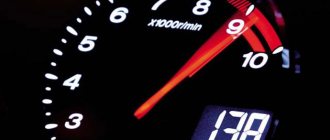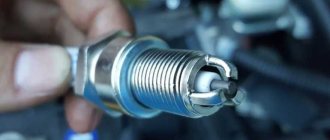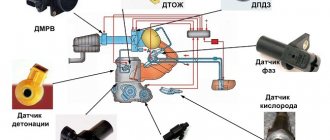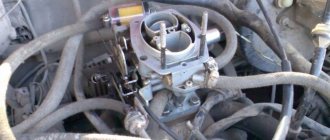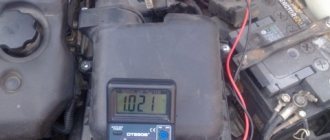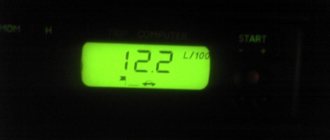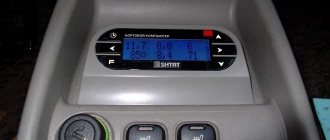Absolutely all Lada Kalina owners are interested in such an indicator as the fuel consumption of their car, and surely each of us wants to make it less. But there are many owners who even dream of factory performance.
The video above shows that the instantaneous consumption of my 8-valve Kalina at a speed of 100 km/h is no more than 5.8 liters, provided that the car has winter tires and the car is almost fully loaded. There is no catch there, AI-92 gasoline, I’m driving on a flat but very good road, I think that with summer tires the numbers would be even lower.
So, over my entire driving experience of 8 years and the total mileage on all my cars is at least 300,000 km, I have several comments and opinions about what can affect fuel consumption and how to moderate the engine’s appetite. This is my personal opinion and I do not impose it on anyone and do not insist that this is 100% true, but judging by my experience, everything was exactly like that.
Factors affecting fuel consumption:
Gasoline quality
This is probably the first point that you can think about in case of increased fuel consumption, because sometimes when refueling at different gas stations, the numbers on the on-board computer can differ significantly, even up to 2 liters per 100 km. This happened to me often, especially when I had to fill up with gasoline from unknown pumps.
I would give advice, if possible, fill up with fuel at trusted gas stations where you are satisfied with the quality. As for the octane number, I almost never notice the difference, especially at local filling stations and even Rosneft, but at Lukoil the 95 differs from the 92 for the better, I have been convinced of this more than once.
Low or uneven tire pressure
I think it’s no secret to anyone that not only the maneuverability and behavior of the car on the highway, but also the fuel consumption of your Lada Kalina depends on the pressure in the wheels. Before filming this video, which is located above, I drove 140 km to the village: so then, at the same speed, the consumption was about 6.5 liters on the same section of the road, but the right front wheel was lowered to 1 atmosphere, here is a real example of this , why did my Kalina eat more then?
Weather and road conditions
Naturally, in winter on a snowy road, the needle on the gasoline gauge will tend to zero faster than in dry weather and on summer tires. Heavy snow or rain, wind - all this negatively affects fuel consumption, as they create enormous resistance to the car body. In winter, of course, you have to spend even more money on gasoline, since you have to constantly warm up the engine.
Engine condition
Anyone who had a new Kalina or another car remembers that during the run-in they had to refuel more often, and after several thousand kilometers everything became normal. And also, if the piston is already worn out enough, the loss of compression will lead to a significant increase in fuel consumption.
DMVR sensor malfunction
This problem was on my previous VAZ 2112 car, where this mass air flow sensor constantly sent an error to the on-board computer and the instantaneous flow increased immediately from 0.6 to 1.3 liters per hour when the engine was idling. I had to constantly reset the error. So keep an eye on and replace the air filter more often than written in the operating instructions, thereby you will extend the life of the mass air flow sensor for many years.
There are still a bunch of different little things that can affect the fuel consumption of the Lada Kalina, from spark plugs to engine oil and the timing of its replacement, but I think it’s better to discuss this below in the comments. I hope that everyone has enough observations and thoughts on this matter.
Driving style and operating conditions
When forming the technical indicators of a specific model, the manufacturer draws data from test results at testing grounds. These conditions differ significantly from the actual situation of subsequent operation. A considerable proportion of owners are prone to driving at high speeds and aggressive driving style. Fuel consumption inevitably increases, and the face of the temperamental driver becomes covered with surprise, turning into despondency. Also, not the best way to save money is to hold back the engine or the so-called “tight” driving.
When fuel consumption is high, this results in excessive loading of the body. This circumstance is especially relevant for owners of Lada Kalina universal modifications. Country driving in low gears will inevitably cause a “jump” in fuel consumption. Let's not ignore traffic jams, in which the owner inevitably loses a valuable fuel resource.
In winter, consumption increases due to the need to warm up the engine for a longer time. Turned on comfort systems (heating, stove, etc.) create the same preconditions for excessive waste of gasoline. Note that in summer gluttony also increases due to a running air conditioner.
Recently, the Lada Kalina has been “honored” of the opportunity to be equipped with an automatic transmission unit. Here, the owner’s leverage over the level of consumption is almost taken away, since the “brain” of the box independently determines the moment of transition to a specific level. Owners of such Kalinas can often be found on online forums, where they, in search of the truth, try to find out: why do their cars “eat” a lot?
Factory standard fuel consumption indicators for Lada Kalina
There are four main models of the Lada Kalina passenger car:
- sedan - has a closed body, with 2-3 rows of seats for the driver and passengers, the trunk is separated from the car interior, there is no lifting door in the rear wall;
- station wagon - has a closed cargo-passenger body, one of the sedan variants, which has an enlarged luggage compartment, is equipped with a lifting door in the rear wall;
- hatchback - has a body with 1-2 rows of driver and passenger seats, with a shortened rear overhang (hence the name - “hatchback” means “short”) and a smaller luggage compartment, equipped with a lift-up door in the rear wall;
- sport - is a sports version, which is equipped with a number of special parts - a bumper, an exhaust pipe tip, sports pedals, alloy wheels, a SAAZ Sport sports suspension, front and rear disc brakes, an original reinforced gearbox.
How to check a generator on a viburnum 8 valve
On Kalina cars, the generator is three-phase and produces alternating current. There is no need to go into too much theory; an ordinary motorist only needs to know how to independently diagnose and repair the installation. This means installing the generator and voltage regulator directly. The fact is that at the output of the power windings the voltage jumps in the range of 10-30 V, and to power the entire on-board network you need 12 V. The first step is to rectify the voltage and then stabilize it.
Real fuel consumption of Lada Kalina (according to reviews from car owners)
Many car owners of the Lada Kalina passenger car complain that in reality, gasoline consumption indicators differ from those specified by the manufacturer. For comparison, let’s look at another information table prepared by specialists taking into account feedback from Lada Kalina car owners.
Lada Kalina, 1.4 l When comparing two information tables, it is clear that the real indicators are indeed higher than the stated factory fuel consumption standards for the Lada Kalina. What are the reasons for this discrepancy between the figures?
The main reasons for the difference between the real and factory gas consumption figures for the Lada Kalina passenger car. There are several reasons for the discrepancy between the Lada Kalina's real gasoline consumption figures and the factory standards. Experienced car enthusiasts identify typical ones among them:
- Type of terrain - driving in the city, on the highway, off-road or mixed type of road (the more complex the type of road, the higher the fuel consumption).
- The driver's driving style is slow driving, fast driving, with sharp acceleration, with sharp braking (the more complex the driving style, the higher the gas consumption).
- The quality of the fuel used - AI-95 gasoline is consumed less than AI-92 gasoline.
- Time of year - in winter, fuel consumption rates will be higher, this is affected by icing of the road surface and frequent warming up of the vehicle itself.
- Traffic jams - due to slow driving and frequent braking, gasoline consumption increases by almost several liters.
- Using additional car devices (for example, air conditioning) – with devices constantly on, gasoline consumption will be 0.5-1 liter more.
In addition to the reasons listed, fuel consumption can be affected by various breakdowns of the vehicle itself:
- incorrect readings of the electronic engine control system due to sensor errors - temperature, mass air flow, oxygen, throttle position;
- abnormal pressure in the fuel system;
- internal combustion engine injector malfunction;
- failure of the catalyst;
- dirty air filter.
To install them, the car owner needs to diagnose the Lada Kalina passenger car. After diagnosing and identifying the causes of malfunctions, the vehicle is repaired.
Operation of climate control
Climate control system
To determine the causes of the malfunction of the unit in question, you first need to find out the principle of its operation and the refrigerant flow pattern. This system in Kalina includes the following elements:
- sensor;
- pipeline;
- radiator;
- fan;
- evaporator.
The air conditioning compressor is located on the BC of the engine. It works by rotating the belt. The compressor shaft is located on the housing. The air conditioner pulley is located on a bearing, which rotates regularly when the engine is running. The important elements of this mechanism are:
- friction clutch;
- electromagnetic drive.
conclusions
If the on-board computer shows significantly more than 8.5 liters (and this is the average consumption in mixed mode), then this is a reason to think about the proper operation of the engine and its systems. If an increase in fuel consumption is detected on the Lada Kalina, the malfunction should be immediately diagnosed and corrected. There were cases when consumption reached 20 liters and only after that did motorists begin to do something. If the owner of a Lada Kalina cannot detect the fault himself, then it is worth contacting a car service center. The consequence of increased consumption may be increased wear of the elements of the power unit, which can lead to unplanned overhauls.
How to fill it yourself?
Before you start refueling, you need to get rid of moisture and air using a vacuum pump.
For Lada Kalina, it is recommended to purchase R-134a freon. For refueling, use a special refueling kit, which has two hoses and a ball valve.
Filling the climate system with freon consists of the following sequence of actions:
- The car needs to be put on the handbrake and put in neutral.
- Before connecting the filling kit hose to the low pressure port, it must be cleaned of dirt.
- When the hose is connected, you need to start the engine.
- The second hose should be connected to the freon cylinder.
- During refilling, you need to press the gas pedal so that the refrigerant is evenly distributed throughout the air conditioning system. Cooled air should enter the cabin.
- When refueling is complete, remove the hose from the low pressure port and screw on the cap.
This completes freon charging. Now you need to turn on the car air conditioner and check how it works.
Disassembling the device
To disassemble the generator, you need to perform several simple manipulations:
- Remove the drive pulley. Try not to lose the key.
- Unscrew the nuts from the back cover that secure all parts of the structure.
- Remove the voltage regulator. At the same time, evaluate the condition of the brush assembly.
- Disconnect all parts of the generator.
After this, you can begin to carry out repairs.
Bearings often fail, especially the one located in the front cover. The reason for this is excessive belt tension. To make a replacement, you need to unscrew four screws and press the bearing out of its seat. Instead, install a new bearing. To increase reliability, change both rollers at once.
Generator operating principle
To visually visualize the operation of the installation, use the generator connection diagram. The second component of the installation is a voltage regulator, which is included in the power circuit of the rotor winding. The instrument panel contains a charge control lamp that:
- Lights up when the ignition is turned on and there is a breakdown in the generator set.
- Does not light up in normal mode and when there is a proper charge level.
A relay with normally closed contacts is used to power this lamp. Therefore, when the ignition is turned on, it lights up. Further, as soon as you start the engine, the generator begins to generate voltage. The relay winding is connected to the rotor power circuit; when voltage appears, the contacts switch - they open and the lamp goes out.

